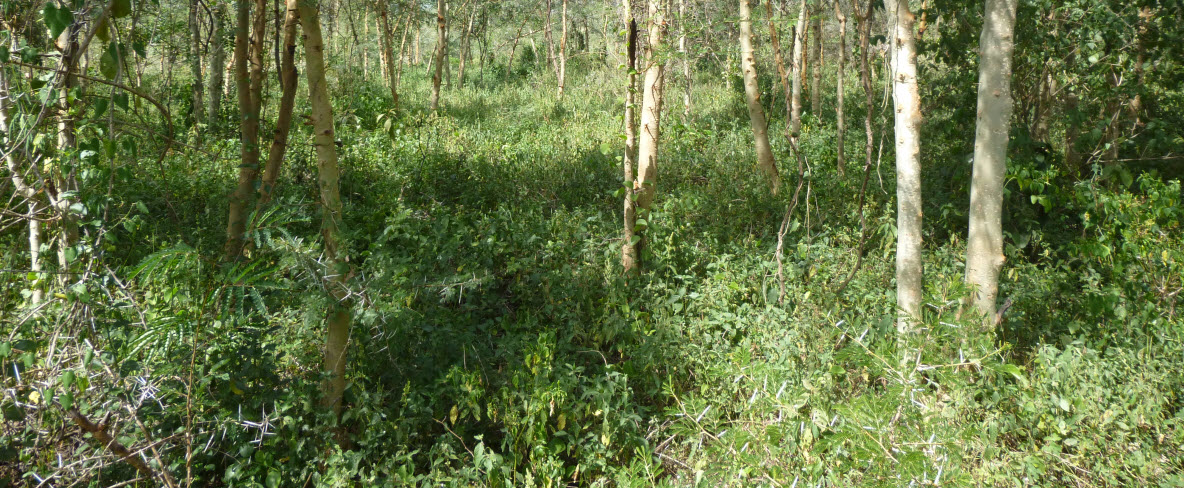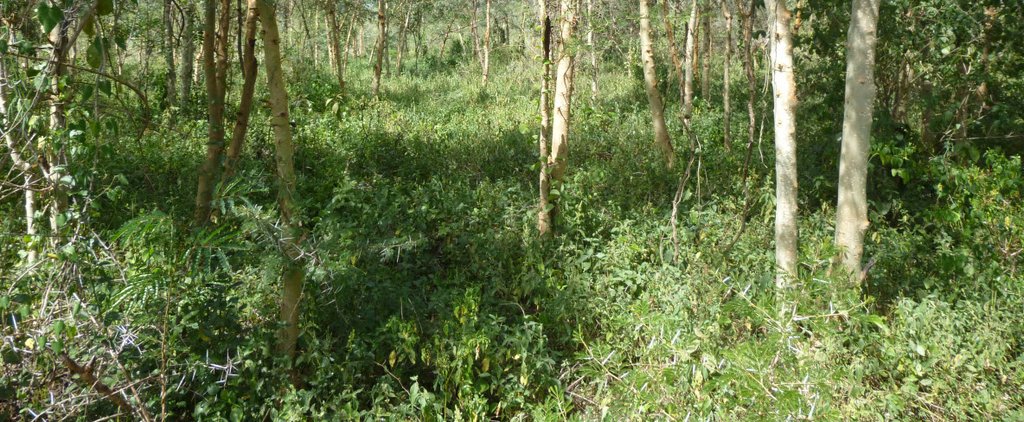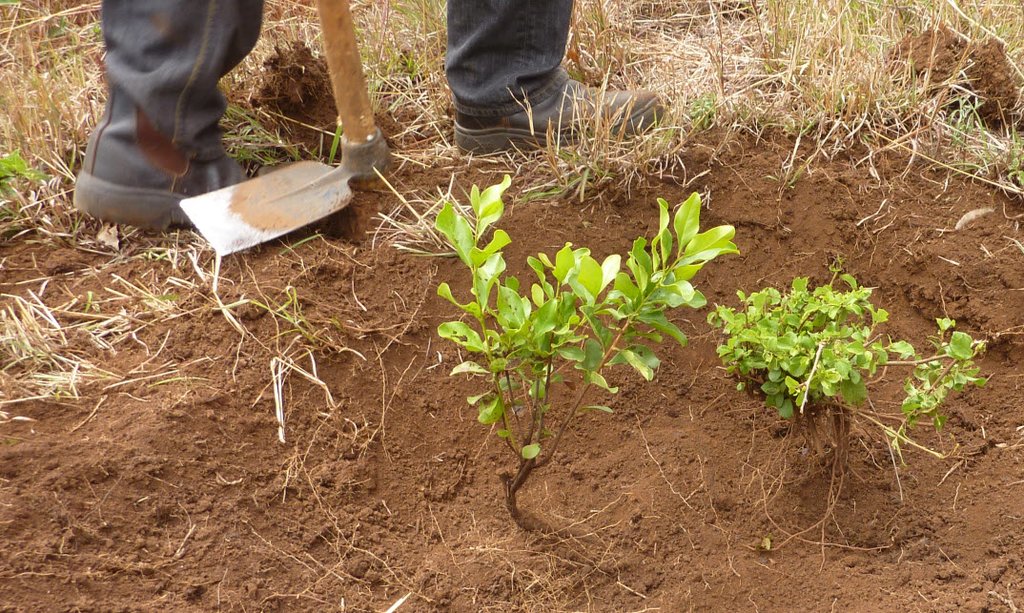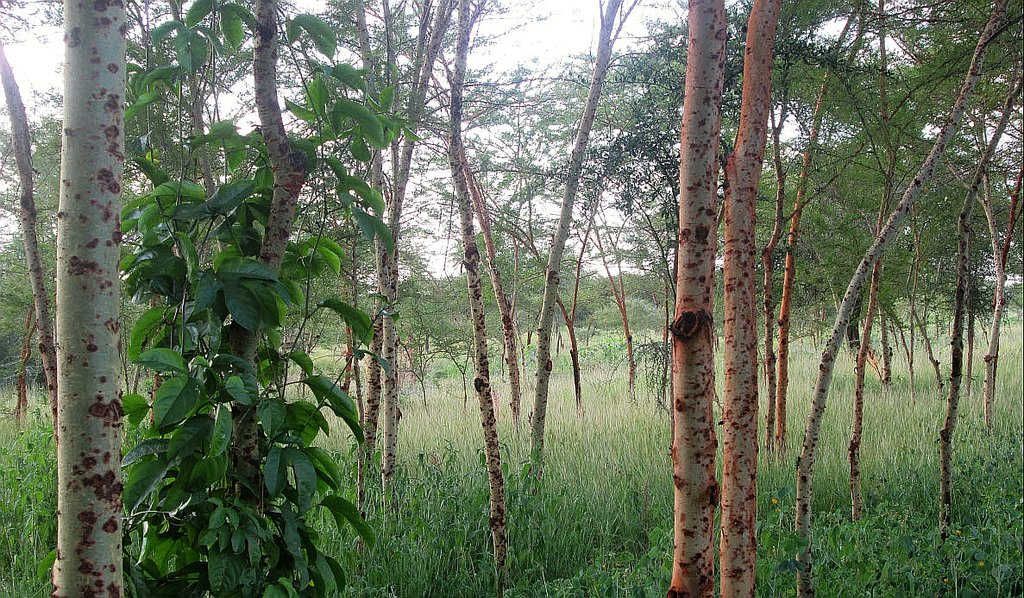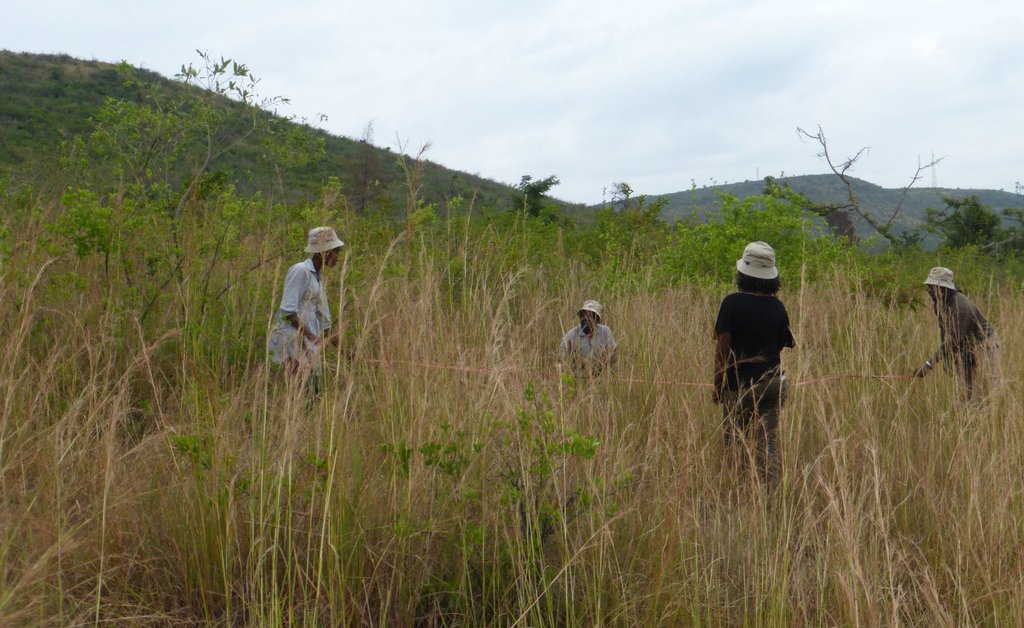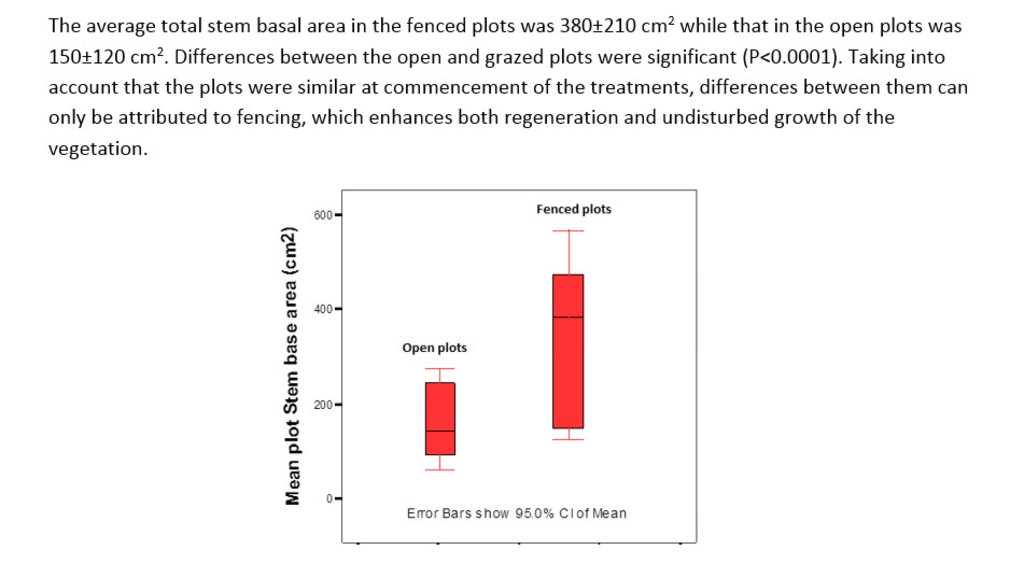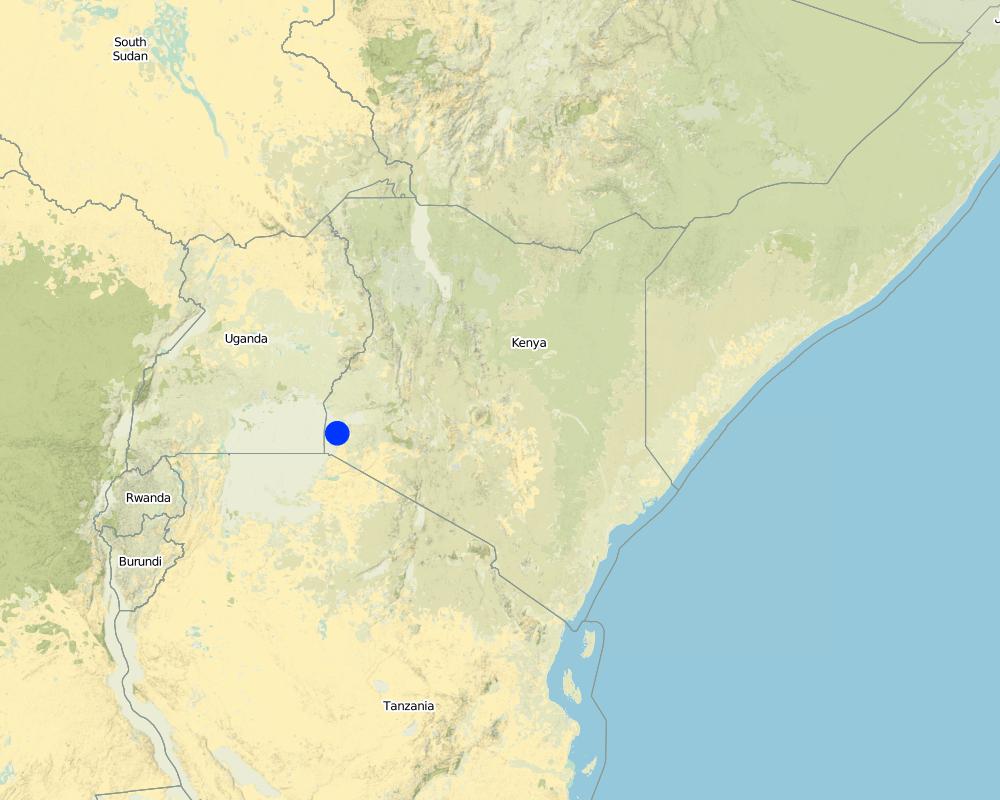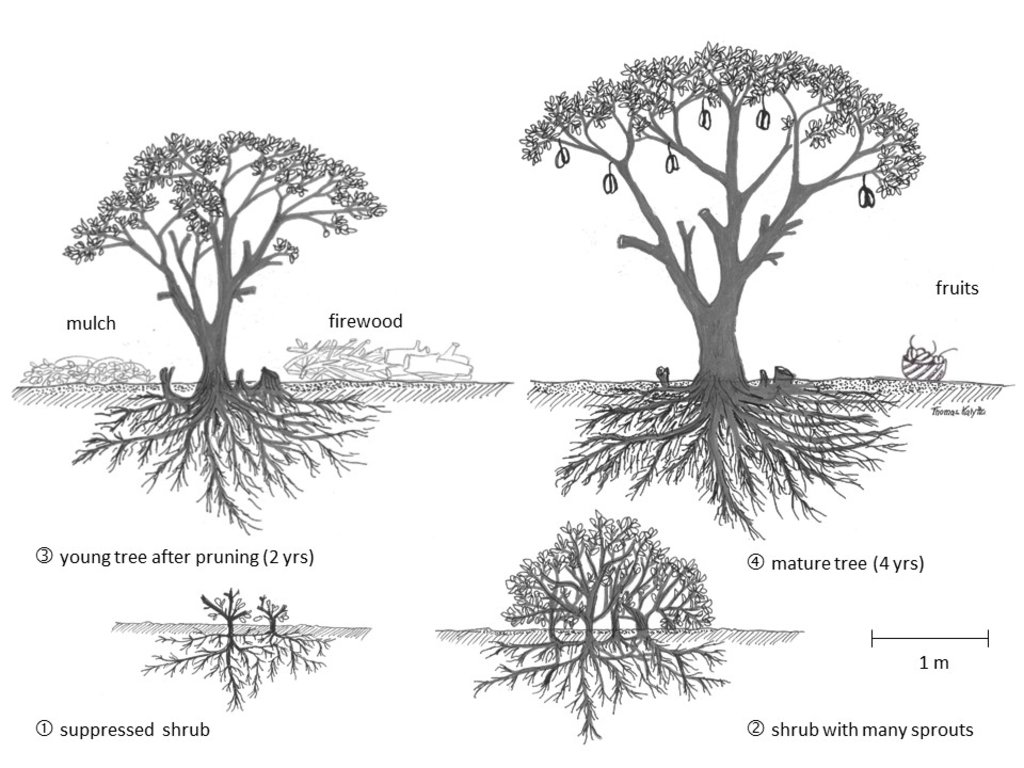Farmer Managed Natural Regeneration (FMNR) [เคนยา]
- ผู้สร้างสรรค์:
- การอัพเดท:
- ผู้รวบรวม: Thomas Kalytta
- ผู้เรียบเรียง: Irene Ojuok
- ผู้ตรวจสอบ: Hanspeter Liniger, Nicole Harari, Alexandra Gavilano, David Streiff, Fabian Ottiger, Mathias Gurtner
FMNR
technologies_507 - เคนยา
ดูส่วนย่อย
ขยายทั้งหมด ย่อทั้งหมด1. ข้อมูลทั่วไป
1.2 รายละเอียดที่ติดต่อได้ของผู้รวบรวมและองค์กรที่เกี่ยวข้องในการประเมินและการจัดเตรียมทำเอกสารของเทคโนโลยี
วิทยากรหลัก
ผู้เชี่ยวชาญ SLM:
Ojuok Irene
World Vision
เคนยา
Kalytta Thomas
World Vision
ผู้ใช้ที่ดิน:
Sijenyi Onyiego William
Obanda Environmental project
เคนยา
ชื่อของโครงการซึ่งอำนวยความสะดวกในการทำเอกสารหรือการประเมินเทคโนโลยี (ถ้าเกี่ยวข้อง)
Book project: where people and their land are safer - A Compendium of Good Practices in Disaster Risk Reduction (DRR) (where people and their land are safer)ชื่อขององค์กรซึ่งอำนวยความสะดวกในการทำเอกสารหรือการประเมินเทคโนโลยี (ถ้าเกี่ยวข้อง)
World Vision (World Vision) - สวิตเซอร์แลนด์1.3 เงื่อนไขการใช้ข้อมูลที่ได้บันทึกผ่านทาง WOCAT
ผู้รวบรวมและวิทยากรหลักยอมรับเงื่อนไขเกี่ยวกับการใช้ข้อมูลที่ถูกบันทึกผ่านทาง WOCAT:
ใช่
1.4 การเปิดเผยเรื่องความยั่งยืนของเทคโนโลยีที่ได้อธิบายไว้
เทคโนโลยีที่ได้อธิบายไว้นี้เป็นปัญหาของความเสื่อมโทรมโทรมของที่ดินหรือไม่ จึงไม่ได้รับการยอมรับว่าเป็นเทคโนโลยีเพื่อการจัดการที่ดินอย่างยั่งยืน:
ไม่ใช่
แสดงความคิดเห็น:
It is a very sustainable technology as it promotes the natural regeneration of highly degraded areas.
1.5 Reference to Questionnaire(s) on SLM Approaches (documented using WOCAT)
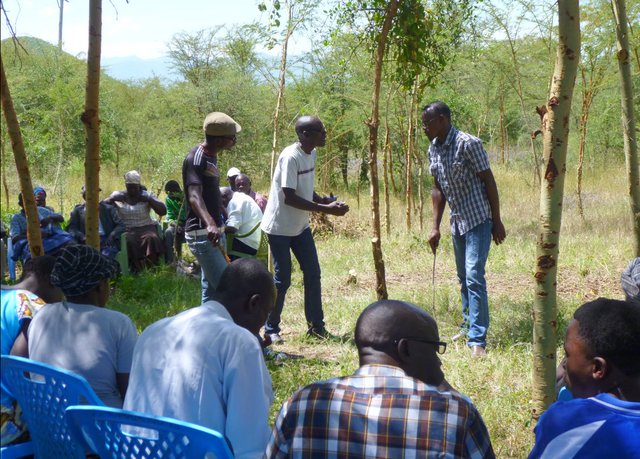
FMNR implementation approach [เคนยา]
After consultations with local stakeholders, experts (from NEMA, ICRAF, KFS, Wildlife Kenya) and Homabay County Government representatives the FMNR approach is being introduced by World Vision through a public funded project. The aim of the approach is to promote FMNR and sustainable land and natural resource management through disseminating the …
- ผู้รวบรวม: Thomas Kalytta
2. การอธิบายลักษณะของเทคโนโลยี SLM
2.1 การอธิบายแบบสั้น ๆ ของเทคโนโลยี
คำจำกัดความของเทคโนโลยี:
Farmer Managed Natural Regeneration (FMNR) is a proven SLM Technology to restore degraded wasteland and improve depleted farmland. The farmer regu- lates and facilitates the re-growth of existing trees stumps, or self-sown seeds in the soil, and thus promotes soil fertility and through better ground cover, increases protection from runoff and erosion.
2.2 การอธิบายแบบละเอียดของเทคโนโลยี
คำอธิบาย:
Conventional afforestation and tree planting requires considerable inputs, labour and care including suitable seedlings, transport of these, planting and regular watering - and the survival rate in arid and semi-arid climates is often very poor. On the other hand Farmer Managed Natural Regeneration (FMNR) is a cheap and effective way to restore and improve large areas of degraded and depleted soils. The technology relies on the fact that even in deforested areas, soils often still maintain some active roots systems and viable seeds of native woody plants. Selectively promoted, leaving only a few main shoots, they can grow into trees within a few years. This technology - based on indigen- ous practices - has been successfully promoted by World Vision in eight African countries including Kenya and Ethiopia, and is now also being applied in Indonesia, East Timor and Latin America. Apart from labour and a farmer’s knife, and skills, there are no major inputs required. The farmers like this agroforestry technology a it is cheap and can be easily combined with other SLM technolo- gies such as permaculture, inter-cropping, and mulching. At the same time it can be used at various scales: on small plots of less than one hectare or up to the landscape level where whole hills can be re-vegetated within a short period. And the impact can be very positive on the soil, ecology, cli- mate and health of crops, people and livestock. The farmer can use prunings as rewood, and grow fodder below the trees; tree branches and leaves can serve for mulching and the owers for bees, fruits for consumption and sale. The trees break the winds, protect the soil and (with some species) their shade protects sensitive crops (e.g. vegetables or even coffee) from the sun. The soil’s water retention capacity, structure, biology and fertility improve. All effects contribute to soil, water and climate stabilization. One limitation can be the use of tractors and other machines which, however, are hardly employed by smallholder farmers. Some practical steps for establishing an FNMR site; 1) jointly agree on a target area (be it a eld or communal wasteland) 2) check out the area carefully for existence of woody species (trees, bushes, rootstocks) 3) mark the bushes or trees that should be nurtured into bigger trees (it is recommended to consult local/scientific knowledge on the trees species and their positive benefits) 4) protect the whole area (fences, hedges) or only the chosen trees against grazing and human disturbance 5) when the plants reach a height of 1 m start with pruning, only keeping the 2-3 main shoots, using the prunings for rewood or mulching 6) watering is in most cases not required as the indigenous trees have well-enough developed roots for self- supply 7) the specific cultivation and management practice depends on the trees species selected and the desired results (intercropping with maize, shade trees for coffee, fodder trees for livestock, flower trees for bees etc.) 8) fire and livestock are the are the main threats for a new FMNR site.
2.3 รูปภาพของเทคโนโลยี
คำอธิบายภาพ:
The photos were taken during 2 years while introducing FMNR to the 1000 small holder farmers in Homabay County.
2.4 วีดีโอของเทคโนโลยี
ความคิดเห็น/อธิบายสั้นๆ:
Tony Rinaudo gives an introduction to Farmer Managed Natural Regeneration Project Model. It is something that can be implemented relatively quickly with a low budget and have a great impact. FMNR has big implications for income generation, Disaster Risk Reduction, reducing proness to famine, conflict reduction, land and forest restoration, food security, climate change adaptation and mitigation... amongst other things.
https://vimeo.com/55277450
วันที่:
2012
สถานที่:
Niger etc.
ชื่อผู้ถ่ายวีดีโอ:
World Vision
ความคิดเห็น/อธิบายสั้นๆ:
(Video in German language)
It is a method with a great success: Farmer Managed Natural Regeneration (FMNR). World Vision employee Tony Rinaudo paves the way to grow trees, where hardly anything is produced. Meanwhile, the people in the Humbo region of Ethiopia are earning money from global emissions trade through greening their country. The World Bank is promoting the project and the local people can now provide for a better future. But in the beginning it was not easy for Tony Rinaudo and his colleagues to convince the farmers to protect the forest!
Es ist eine Methode, die durchschlagenden Erfolg hat: Farmer Managed Natural Regeneration (FMNR).
World Vision Mitarbeiter Tony Rinaudo lässt Bäume aufwachsen, wo das Land kaum noch etwas hervorbringt. Mittlerweile verdienen die Menschen in der Region Humbo in Äthiopien durch die Wiederbegrünung Geld im weltweiten Emissionshandel. Die Weltbank fördert das Projekt und die Menschen vor Ort können nun selbst für eine bessere Zukunft sorgen. Doch am Anfang war es nicht leicht für Tony Rinaudo und seine Mitstreiter, die Bauern davon zu überzeugen den Wald zu schützen!
https://vimeo.com/189822143
วันที่:
26/06/2012
สถานที่:
Humbo, Ethiopia
ชื่อผู้ถ่ายวีดีโอ:
World Vision
ความคิดเห็น/อธิบายสั้นๆ:
Original (edited) footage of a 1990 visit to Niger where Farmer Managed Natural Regeneration (FMNR) was being practiced. Features an interview with Tony Rinaudo and one of the early adopters. Tony was a SIM missionary who pioneered and developed this management practice. It is now being practiced on millions of hectares in Niger and other countries in the Sahel. Part 1: https://vimeo.com/189821376
Part 2: https://vimeo.com/189821948
วันที่:
1990
สถานที่:
Niger
ชื่อผู้ถ่ายวีดีโอ:
Barry Rands
2.5 ประเทศภูมิภาค หรือสถานที่ตั้งที่เทคโนโลยีได้นำไปใช้และได้รับการครอบคลุมโดยการประเมินนี้
ประเทศ:
เคนยา
ภูมิภาค/รัฐ/จังหวัด:
Homa Bay Country
ข้อมูลจำเพาะเพิ่มเติมของสถานที่ตั้ง :
Suba and Mbita Sub-Counties
ระบุการกระจายตัวของเทคโนโลยี:
- กระจายไปอย่างสม่ำเสมอในพื้นที่
If precise area is not known, indicate approximate area covered:
- 1-10 ตร.กม.
แสดงความคิดเห็น:
Only 16 of the initial FMNR sites are reflected above:
1,-0.55,34.215,1202,Sumba West ,Lambwe,Abong'o agroforestry farm,Mon Sep 01 00:00:00 UTC 2014,Yes,Borehole 4,Bucket or watering can,1,0,1,"Agroforestry management,soil testing and +fmnr",4
2,-0.546,34.209,1223,Sumba west ,Lambwe,Abuto's +fmnr,Fri Aug 01 00:00:00 UTC 2014,Yes,Borehole,N/A,1,0,1,+fmnr farm,,https://wvksurveys.appspot.com/view/binaryData?blobKey=WVK_Livelihoods_2014%5B%40version%3Dnull+and+%40uiVersion%3Dnull%5D%2FWVK_Livelihoods_2014%5B%40key%3Duuid%3A7afa8c53-61f2-46ff-a191-9ebd393b0145%5D%2Fimage_test
4,-0.617,34.333,1171,Ogongo ,Lambwe,Aloice +fmnr demonstration farm,Sat Sep 13 00:00:00 UTC 1997,Yes,"Borehole, Rainwater, lake and Others",N/A,1,0,1,+fmnr Demonstration farm.,3
5,-0.621,34.331,1154,Ogongo ,Lambwe,Arise and Shine Ojawa YG,Wed Jan 01 00:00:00 UTC 2014,Yes,Pond,Bucket or watering can,11,5,6,"Tree nursery, tree planting, +fmnr, bee keeping, maize farming 4acres, Agro forestry, chairs for hire, fruit trees.",10
6,-0.612,34.337,1191,Ogongo ,Lambwe,Clements +fmnr site,Tue Aug 13 00:00:00 UTC 2013,Yes,"Rainwater, lake and Others",N/A,2,1,1,+fmnr established site,1 acre,https://wvksurveys.appspot.com/view/binaryData?blobKey=WVK_Livelihoods_2014%5B%40version%3Dnull+and+%40uiVersion%3Dnull%5D%2FWVK_Livelihoods_2014%5B%40key%3Duuid%3Af68584de-5b53-465a-9177-01159ef0ff3f%5D%2Fimage_test
7,-0.541,34.392,1163,Ruri East,Lambwe,Eliakims +fmnr site,Sun Jun 01 00:00:00 UTC 2014,Yes,Borehole,N/A,1,1,1,Household +fmnr site and bee keeping.,2 acres,https://wvksurveys.appspot.com/view/binaryData?blobKey=WVK_Livelihoods_2014%5B%40version%3Dnull+and+%40uiVersion%3Dnull%5D%2FWVK_Livelihoods_2014%5B%40key%3Duuid%3A825648e7-1fa4-4be8-b051-83adc8748e0b%5D%2Fimage_test
10,-0.562,34.324,1204,Got jope ,Lambwe,Got Jope +fmnr Biodiversity site,Wed Aug 13 00:00:00 UTC 2014,Yes,"Rainwater, lake and Others",N/A,0,,,+fmnr site fenced off for natural re generation,2
11,-0.535,34.406,1172,Got Rabondo,Lambwe,Gotrabondo +fmnr,Tue Jan 13 00:00:00 UTC 2015,Yes,"Rainwater, lake and Others",N/A,,,,Proposed +fmnr site,0.5 acres,https://wvksurveys.appspot.com/view/binaryData?blobKey=WVK_Livelihoods_2014%5B%40version%3Dnull+and+%40uiVersion%3Dnull%5D%2FWVK_Livelihoods_2014%5B%40key%3Duuid%3A544ec602-66ad-4e15-9053-1471c78f53ad%5D%2Fimage_test
19,-0.576,34.368,1243,Godjope,Lambwe,Ngufu youth group,Tue Jan 06 00:00:00 UTC 1998,Yes,Open well,Bucket or watering can,7000,4500,2500,+fmnr site,6Average of 2.5acres per household,https://wvksurveys.appspot.com/view/binaryData?blobKey=WVK_Livelihoods_2014%5B%40version%3Dnull+and+%40uiVersion%3Dnull%5D%2FWVK_Livelihoods_2014%5B%40key%3Duuid%3Ae64b2ac5-0beb-4780-aa51-595c3a31d3c7%5D%2Fimage_test
22,-0.6,34.25,1336,Nyandenda ,Lambwe,Nyakia CBO,Tue Jan 03 00:00:00 UTC 2012,Yes,Open well,Bucket or watering can,35,15,20,"Bee keeping, +fmnr, Agro forestry",0.5 acres,https://wvksurveys.appspot.com/view/binaryData?blobKey=WVK_Livelihoods_2014%5B%40version%3Dnull+and+%40uiVersion%3Dnull%5D%2FWVK_Livelihoods_2014%5B%40key%3Duuid%3A792b57df-7a7f-4e43-9643-8d801e3b39be%5D%2Fimage_test
26,-0.546,34.343,1234,God jope ,Lambwe,Obanda environmental group,Tue Jul 01 00:00:00 UTC 2014,Yes,"Rainwater, lake and Others",Bucket or watering can,7,2,5,"+fmnr , tree nursery and soil and water conservation",20 acres,https://wvksurveys.appspot.com/view/binaryData?blobKey=WVK_Livelihoods_2014%5B%40version%3Dnull+and+%40uiVersion%3Dnull%5D%2FWVK_Livelihoods_2014%5B%40key%3Duuid%3A73b33675-a5be-4579-b31a-51ec366c6c6f%5D%2Fimage_test
28,-0.599,34.335,1175,Ogongo ,Lambwe,Ogando youth group,Sat Oct 13 00:00:00 UTC 2012,Yes,Pond,Bucket or watering can,19,6,13,"Tree nursery, kitchen vegetable gardening, tree planting, agroforestry, proposed green house farming, proceeds from tree nursery support livestock purchase, fruit tree I.e grafted mangoes, +fmnr",4 acres,https://wvksurveys.appspot.com/view/binaryData?blobKey=WVK_Livelihoods_2014%5B%40version%3Dnull+and+%40uiVersion%3Dnull%5D%2FWVK_Livelihoods_2014%5B%40key%3Duuid%3A70cf4828-4a0d-4ae5-a122-ce3654cb8242%5D%2Fimage_test
32,-0.528,34.172,1122,Sindo ,Lambwe,Osumbas +fmnr farm,Wed Jul 02 00:00:00 UTC 2014,Yes,"Rainwater, lake and Others",N/A,,,,+fmnr farm ,3 acres,https://wvksurveys.appspot.com/view/binaryData?blobKey=WVK_Livelihoods_2014%5B%40version%3Dnull+and+%40uiVersion%3Dnull%5D%2FWVK_Livelihoods_2014%5B%40key%3Duuid%3Ac8c7fa0c-80a6-4790-bddc-d4ac003bc4ba%5D%2Fimage_test
34,-0.547,34.169,1136,Rang'wa East ,Lambwe,Samuel obado Demonstration farm,Wed May 14 00:00:00 UTC 2014,Yes,"Rainwater, lake and Others",Bucket or watering can,1,0,1,+fmnr Demonstration farm.,3
37,-0.623,34.25,1213,Nyandenda ,Lambwe,Violet simba-individual,Tue Jan 03 00:00:00 UTC 2012,Yes,Open well,Bucket or watering can,1,1,0,"+fmnr Agro forestry, fruit trees, bee keeping, tree nursery",3
Map
×2.6 วันที่การดำเนินการ
ระบุปีที่ใช้:
2014
ถ้าไม่รู้ปีที่แน่นอน ให้ระบุวันที่โดยประมาณ:
- น้อยกว่า 10 ปี (ไม่นานนี้)
2.7 คำแนะนำของเทคโนโลยี
ให้ระบุว่าเทคโนโลยีถูกแนะนำเข้ามาอย่างไร:
- ทางโครงการหรือจากภายนอก
ความคิดเห็น (ประเภทของโครงการ เป็นต้น) :
The technology was introduced by World Vision through a public funded project on climate protection and natural resource management. It received the “Total Kenya Eco Challenge Award” in 2016. The introduction was done through the following steps. The project staff were trained on the concept after which they trained Government staff in forestry, education and agriculture department including chiefs and assistant chief who were to turn out to be the entry point/ ambassadors for the concept. Intense trainings, awareness campaigns, practical demonstrations, consultative meetings and observations were conducted. Till now more than 300 hectares of degraded land was reclaimed through FMNR and over 1000 farmers adopted the practice already.
3. การจัดประเภทของเทคโนโลยี SLM
3.1 วัตถุประสงค์หลักของเทคโนโลยี
- ปรับปรุงการผลิตให้ดีขึ้น
- ลด ป้องกัน ฟื้นฟู การเสื่อมโทรมของที่ดิน
- อนุรักษ์ระบบนิเวศน์
- ป้องกันพื้นที่ลุ่มน้ำ/บริเวณท้ายน้ำ โดยร่วมกับเทคโนโลยีอื่นๆ
- รักษาสภาพหรือปรับปรุงความหลากหลายทางชีวภาพ
- ลดความเสี่ยงของภัยพิบัติ
- ปรับตัวเข้ากับการเปลี่ยนแปลงภูมิอากาศของโลก สภาพภูมิอากาศที่รุนแรงและผลกระทบ
- ชะลอการเปลี่ยนแปลงภูมิอากาศของโลกและผลกระทบ
- สร้างผลกระทบทางด้านเศรษฐกิจที่เป็นประโยชน์
- this technology brings a lot of positive effects on the environment (more water, more carbon and nutrients in the soil, better micro climate etc.) > bullet point 4: other technologies could be contour farming, agroforestry, water harvesting)
3.2 ประเภทของการใช้ที่ดินในปัจจุบันที่ได้นำเทคโนโลยีไปใช้
Land use mixed within the same land unit:
ใช่
Specify mixed land use (crops/ grazing/ trees):
- วนเกษตร (Agroforestry)

พื้นที่ปลูกพืช
- การปลูกพืชล้มลุกอายุปีเดียว
- การปลูกไม้ยืนต้น ไม้พุ่ม
Annual cropping - Specify crops:
- cereals - maize
- cereals - millet
- cereals - quinoa or amaranth
- cereals - sorghum
- legumes and pulses - beans
- vegetables - other
- coffee, passion fruit
จำนวนของฤดูเพาะปลูกต่อปี:
- 1
ระบุ:
There is no planting required but protection of FMNR plots. The shrubs grow best in the rainy season.

ป่า/พื้นที่ทำไม้
Type of tree:
- Acacia species
ผลิตภัณฑ์และบริการ:
- ไม้ที่นำมาทำเป็นเชื้อเพลิง
- ผลไม้และถั่ว
- ผลิตภัณฑ์อื่น ๆ จากป่า
- การแทะเล็มหญ้า / การเก็บกินหญ้า
- Bee pasture

ที่ดินที่ไม่ให้ผลผลิต
ระบุ:
degraded wasteland
ข้อสังเกต:
Many of the typical hills and areas in Suba Sub-County are degraded and without forest anymore. Over exploitation through grazing and charcoal burning led to deforestation and soil degradation. Most of the water streams have disappeared in the meantime. The climate has become more harsh and arid. The native trees grown through FMNR provide shade, organic matter, fruits, fodder, fire wood, bee pasture etc.
แสดงความคิดเห็น:
Main products/ services: The native trees provide shade, organic matter, fruits, fodder, firewood, bee pasture etc.
Typical crops in Kenya grown below the FMNR trees are maize, millet, mung beans, amaranth and sorghum, vegetables and coffee. It can be an advantage to promote the growth of Leguminous trees as they serve as source of nitrogen and many of them produce pods eaten by livestock.
Livestock density: Livestock is one of the main threats to the technology. It is a very important to keep livestock out of the FMNR areas either by using live fences or mesh wire fences.
3.4 การใช้น้ำ
การใช้น้ำของที่ดินที่มีการใช้เทคโนโลยีอยู่:
- จากน้ำฝน
แสดงความคิดเห็น:
Since only indigenous species are promoted the normal rainfall should be sufficient for their growth.
3.5 กลุ่ม SLM ที่ตรงกับเทคโนโลยีนี้
- การจัดการป่าธรรมชาติและกึ่งธรรมชาติ
- การปลูกป่าร่วมกับพืช
- การปรับปรุงดิน / พืชคลุมดิน
3.6 มาตรการ SLM ที่ประกอบกันเป็นเทคโนโลยี

มาตรการอนุรักษ์ด้วยวิธีพืช
- V1: ต้นไม้และพุ่มไม้คลุมดิน
แสดงความคิดเห็น:
There is also an aspect of management change (M2): allowing the native trees to grow, pruning of upcoming bushes, mulching with tree branches, felling of trees when desired etc.
3.7 รูปแบบหลักของการเสื่อมโทรมของที่ดินที่ได้รับการแก้ไขโดยเทคโนโลยี

การกัดกร่อนของดินโดยน้ำ
- Wt (Loss of topsoil): การสูญเสียดินชั้นบนหรือการกัดกร่อนที่ผิวดิน
- Wg (Gully erosion): การกัดกร่อนแบบร่องธารหรือการทำให้เกิดร่องน้ำเซาะ

การกัดกร่อนของดินโดยลม
- Et (Loss of topsoil): การสูญเสียดินชั้นบน

การเสื่อมโทรมของดินทางด้านชีวภาพ
- Bc (Reduction of vegetation cover): การลดลงของจำนวนพืชที่ปกคลุมดิน
- Bq (Quantity/biomass decline): การลดลงของปริมาณหรือมวลชีวภาพ
- Bs (Quality and species composition): องค์ประกอบหรือความหลากหลายทางคุณภาพและชนิดพันธุ์ลดลง
แสดงความคิดเห็น:
FMNR contributes to less soil erosion, more organic matter and more diversified habitats (leading to increased agro-biodiversity).
3.8 การป้องกัน การลดลง หรือการฟื้นฟูความเสื่อมโทรมของที่ดิน
ระบุเป้าหมายของเทคโนโลยีกับความเสื่อมโทรมของที่ดิน:
- ลดความเสื่อมโทรมของดิน
- ฟื้นฟูบำบัดที่ดินที่เสื่อมโทรมลงอย่างมาก
แสดงความคิดเห็น:
FMNR contributes to less land degradation and is an ideal technology to restore severely degraded areas.
4. ข้อมูลจำเพาะด้านเทคนิค กิจกรรมการนำไปปฏิบัติใช้ ปัจจัยนำเข้า และค่าใช้จ่าย
4.1 แบบแปลนทางเทคนิคของเทคโนโลยี
ข้อมูลจำเพาะด้านเทคนิค (แบบแปลนทางเทคนิคของเทคโนโลยี):
The technical drawing above shows four typical stages of an indiginous tree in a FMNR site:
1) a suppressed shrub, very damaged by roaming animals or human interference
2) if this small shrub experience protection it will regenerate and grow many new branches
3) as soon as a bush has reached a height of 1 m the farmer can start with pruning keeping only a few major branches. This will help the tree to grow high and the farmer can yield branches and leaves for fire wood and mulching. Depending on the growth rate, pruning can be done 1-2 times a year.
4) A mature tree produces also fruits that can be harvested. As only major branches remain enough sunlight will reach the ground to allow the cultivation of crops or gras production.
Slope and spacing can varry a lot (from 5 to 50 m distance) as FMNR is designed to be extremely flexible, giving farmers considerable freedom of individual choice on how to meet their own specific needs, using the free materials at hand (species mix), responding to the specific climate, soils, crop mix, and their own understanding, at the time of implementation. FMNR is being introduced into many different contexts where the environment and species mix, the specific land use (crop land, pasture or forest) and farmer needs, vary from region to region and even from farm to farm.
To date, FMNR has been successfully practiced in a variety of locally adapted ways such as:
- By individual farmers on their own land
- By communities on communal lands and in degraded forests
- By leaving very few trees (10 - 20 / ha), or by leaving very many (150 trees/ ha).
- By focusing on tree species predominantly used to provide firewood and building poles, or on species that have nutritious leaves that feed families or animals. Some use trees that fix nitrogen and can therefore increase the soil fertility for crops.
- Leaving a single stem to grow from a stump (and harvesting when larger), or by leaving multiple stems,
successively harvesting one each year.
- Allowing a single stem to grow into a permanent tree, and then harvesting 1/2 to 1/3rd of the branches per
year (such as pollarding). Pollarding provides larger wood harvests and more rapid re-growth.
- Allowing tree re-growth only on farm borders. The trees are allowed to grow close to each other and are
pruned high up the trunk. As need arises whole trees are harvested and re-growth is allowed to replace
the tree that was harvested.
- Leaving only trees, which are growing approximately in straight lines and moving self-sown seedlings and replanting them within these lines. Within the rows the trees are grown as bushes which are slashed to ground level during the rainy season, except for single stems that are allowed to grow about every 12 meters. This is done to avoid interference with ploughing and because soil infertility is a major issue, addressed by mulching with pruned branches.
ผู้เขียน:
Thomas Kalytta
วันที่:
12/10/2016
4.2 ข้อมูลทั่วไปเกี่ยวกับการคำนวณปัจจัยนำเข้าและค่าใช้จ่าย
ให้ระบุว่าค่าใช้จ่ายและปัจจัยนำเข้าได้รับการคำนวณอย่างไร:
- ต่อพื้นที่ที่ใช้เทคโนโลยี
ระบุขนาดและหน่วยพื้นที่:
1
If using a local area unit, indicate conversion factor to one hectare (e.g. 1 ha = 2.47 acres): 1 ha =:
ha
อื่นๆ หรือสกุลเงินประจำชาติ (ระบุ):
KES
If relevant, indicate exchange rate from USD to local currency (e.g. 1 USD = 79.9 Brazilian Real): 1 USD =:
100.0
ระบุค่าเฉลี่ยของค่าจ้างในการจ้างแรงงานต่อวัน:
400 Kenyan Shillings
4.3 กิจกรรมเพื่อการจัดตั้ง
| กิจกรรม | Timing (season) | |
|---|---|---|
| 1. | Plot inspection (to identify and mark potential bushes) | ideally after harvesting the crops, best time for transects |
| 2. | Plot protection (fencing against livestock) | ideally after harvesting, best time for transects, before planting |
| 3. | alternatively: Protection measures of single bushes | ideally after harvesting, best time for transects, before planting |
| 4. | Weeding/ clearance of surplus bushes/ vegetation | all year, during vegetation period |
| 5. | normal farming activities within the FMNR site | after harvesting the crops |
| 6. | Integrating beekeeping and or fodder harvesting | all year, during vegetative period |
| 7. | Thinning or harvesting of fuel wood | As per need, dependant on the farmer, all year round |
แสดงความคิดเห็น:
Ideally, FMNR activities are not interfering too much with the normal farming activities except for mulching or compost making wherefore small tree branches can be used.
4.4 ค่าใช้จ่ายของปัจจัยนำเข้าที่จำเป็นสำหรับการจัดตั้ง
| ปัจจัยนำเข้า | หน่วย | ปริมาณ | ค่าใช้จ่ายต่อหน่วย | ค่าใช้จ่ายทั้งหมดต่อปัจจัยนำเข้า | %ของค่าใช้จ่ายที่ก่อให้เกิดขึ้นโดยผู้ใช้ที่ดิน | |
|---|---|---|---|---|---|---|
| แรงงาน | plot protection - fencing/ ha | person-days | 30.0 | 400.0 | 12000.0 | 100.0 |
| แรงงาน | tree protection - first pruning/ ha | person-days | 10.0 | 400.0 | 4000.0 | 100.0 |
| อุปกรณ์ | farmer's knife | piece | 2.0 | 150.0 | 300.0 | 100.0 |
| อุปกรณ์ | machete | piece | 2.0 | 500.0 | 1000.0 | 100.0 |
| อุปกรณ์ | rake | piece | 2.0 | 500.0 | 1000.0 | 100.0 |
| อุปกรณ์ | hand hoe | piece | 2.0 | 450.0 | 900.0 | 100.0 |
| อุปกรณ์ | leather gloves | pair | 2.0 | 1000.0 | 2000.0 | 100.0 |
| อุปกรณ์ | strong gumboots | pair | 2.0 | 2000.0 | 4000.0 | 100.0 |
| อุปกรณ์ | axe | piece | 2.0 | 700.0 | 1400.0 | 100.0 |
| วัสดุด้านพืช | life fence seeds/ thorns of shrubs / ha | seedlings | 1200.0 | 5.0 | 6000.0 | 100.0 |
| ปุ๋ยและสารฆ่า/ยับยั้งการเจริญเติบโตของสิ่งมีชีวิต (ไบโอไซด์) | n/a | |||||
| วัสดุสำหรับก่อสร้าง | n/a | |||||
| อื่น ๆ | n/a | |||||
| ค่าใช้จ่ายทั้งหมดของการจัดตั้งเทคโนโลยี | 32600.0 | |||||
| Total costs for establishment of the Technology in USD | 326.0 | |||||
If you are unable to break down the costs in the table above, give an estimation of the total costs of establishing the Technology:
32600.0
ถ้าผู้ใช้ที่ดินรับภาระน้อยกว่า 100% ของค่าใช้จ่าย ให้ระบุว่าใครเป็นผู้รับผิดชอบส่วนที่เหลือ:
The farmer harvest wood and non-wood products like honey and grass. Often FMNR is combined with agriculture or animal husbandry. As the crop yield increases the farmer can invest in more equipment and tools.
แสดงความคิดเห็น:
Some of the costs incurred were covered by WV during inception of the project model of FMNR especially for the demonstration plots but the costs on household level are covered by the farmers themselves. Normal farm equipment is being used to establish the sites. The farmer needs some gloves und gumboots and the time for the additional works. Also some time is needed to be invested for training to get equipped with the required knowledge and skills. Live fence plants or throns from shrubs are normally collected/ taken from the pruned Acacia branches.
4.5 การบำรุงรักษาสภาพหรือกิจกรรมที่เกิดขึ้นเป็นประจำ
| กิจกรรม | ช่วงระยะเวลา/ความถี่ | |
|---|---|---|
| 1. | Pruning of target bushes and trees | during vegetation period, ideally in the dry season |
| 2. | tree felling | after vegetation period, after harvesting the crops |
| 3. | Harvesting of grass in FMNR sites not on crops | During and after rainny season |
แสดงความคิดเห็น:
Ideally, FMNR activities are not interfering too much with the normal farming activities except for mulching or compost making wherefore small tree branches can be used for firewood. In places where FMNR is applied to gain timber, branches and firewood in a sustainable way, it has supported to raise more income for households allowing them to meet their basic needs including school fees, medical bills etc.
4.6 ค่าใช้จ่ายของปัจจัยนำเข้าและกิจกรรมที่เกิดขึ้นเป็นประจำที่ต้องการการบำรุงรักษา (ต่อปี)
| ปัจจัยนำเข้า | หน่วย | ปริมาณ | ค่าใช้จ่ายต่อหน่วย | ค่าใช้จ่ายทั้งหมดต่อปัจจัยนำเข้า | %ของค่าใช้จ่ายที่ก่อให้เกิดขึ้นโดยผู้ใช้ที่ดิน | |
|---|---|---|---|---|---|---|
| แรงงาน | Yearly Pruning of target bushes and trees /ha | person-days | 6.0 | 400.0 | 2400.0 | 100.0 |
| แรงงาน | tree felling of selected trees/ ha | person-days | 4.0 | 400.0 | 1600.0 | 100.0 |
| อุปกรณ์ | farmer's knife | piece | 2.0 | 150.0 | 300.0 | 100.0 |
| อุปกรณ์ | machete | piece | 2.0 | 500.0 | 1000.0 | 100.0 |
| อุปกรณ์ | rake | piece | 2.0 | 500.0 | 1000.0 | 100.0 |
| อุปกรณ์ | hand hoe | piece | 2.0 | 450.0 | 900.0 | 100.0 |
| ค่าใช้จ่ายทั้งหมดของการบำรุงรักษาสภาพเทคโนโลยี | 7200.0 | |||||
| Total costs for maintenance of the Technology in USD | 72.0 | |||||
If you are unable to break down the costs in the table above, give an estimation of the total costs of maintaining the Technology:
14600.0
ถ้าผู้ใช้ที่ดินรับภาระน้อยกว่า 100% ของค่าใช้จ่าย ให้ระบุว่าใครเป็นผู้รับผิดชอบส่วนที่เหลือ:
The farmer harvest wood and non-wood products like honey and grass. Often FMNR is combined with agriculture or animal husbandry. As the crop yield increases the farmer can invest in more equipment and tools.
แสดงความคิดเห็น:
Some of the costs incurred were covered by WV during inception of the project model of FMNR especially for the demonstration plots but the costs on household level are covered by the farmers themselves. Normal farm equipment is being used to establish the sites. The farmer needs some gloves und gumboots and the time for the additional works. Also some time is needed to be invested for training to get equipped with the required knowledge and skills. Live fence plants or throns from shrubs are normally collected/ taken from the pruned Acacia branches.
4.7 ปัจจัยสำคัญที่สุดที่มีผลกระทบต่อค่าใช้จ่าย
ปัจจัยสำคัญที่สุดที่มีผลกระทบต่อค่าใช้จ่ายต่างๆ:
Size of the FMNR site and the density and age of trees. Important precondition is fencing off the sites/ protection of trees against livestock. Most of the equipment needed is part of the normal agricultural tool set.
5. สิ่งแวดล้อมทางธรรมชาติและของมนุษย์
5.1 ภูมิอากาศ
ฝนประจำปี
- < 250 ม.ม.
- 251-500 ม.ม.
- 501-750 ม.ม.
- 751-1,000 ม.ม.
- 1,001-1,500 ม.ม.
- 1,501-2,000 ม.ม.
- 2,001-3,000 ม.ม.
- 3,001-4,000 ม.ม.
- > 4,000 ม.ม.
ระบุปริมาณน้ำฝนเฉลี่ยรายปี (ถ้ารู้) :หน่วย ม.ม.
1350.00
ข้อมูลจำเพาะ/ความคิดเห็นเรื่องปริมาณน้ำฝน:
The precipitation varies a lot within the area/ county.
Daily maximum temperatures range between 26°C during the coldest months (April and November) and 34°C during the hottest months (January to March).
ระบุชื่อของสถานีตรวดวัดอากาศที่ใช้อ้างอิงคือ:
Homa Bay, Homabay Airport, NY, Kenya (lat -0.6000°, long 34.4670°, altitude 1305 metres)
เขตภูมิอากาศเกษตร
- กึ่งแห้งแล้ง
Rainfall is distributed over two rainy seasons: April-May (long rains) and September to November (short rains).
5.2 สภาพภูมิประเทศ
ค่าเฉลี่ยความลาดชัน:
- ราบเรียบ (0-2%)
- ลาดที่ไม่ชัน (3-5%)
- ปานกลาง (6-10%)
- เป็นลูกคลื่น (11-15%)
- เป็นเนิน (16-30%)
- ชัน (31-60%)
- ชันมาก (>60%)
ธรณีสัณฐาน:
- ที่ราบสูง/ที่ราบ
- สันเขา
- ไหล่เขา
- ไหล่เนินเขา
- ตีนเนิน
- หุบเขา
ระดับความสูง:
- 0-100 เมตร
- 101-500 เมตร
- 501-1,000 เมตร
- 1,001-1,500 เมตร
- 1,501-2,000 เมตร
- 2,001-2,500 เมตร
- 2,501-3,000 เมตร
- 3,001-4,000 เมตร
- > 4,000 เมตร
ให้ระบุถ้าเทคโนโลยีได้ถูกนำไปใช้:
- ไม่เกี่ยวข้อง
5.3 ดิน
ค่าเฉลี่ยความลึกของดิน:
- ตื้นมาก (0-20 ซ.ม.)
- ตื้น (21-50 ซ.ม.)
- ลึกปานกลาง (51-80 ซ.ม.)
- ลึก (81-120 ซ.ม.)
- ลึกมาก (>120 ซ.ม.)
เนื้อดิน (ดินชั้นบน):
- ปานกลาง (ดินร่วน ทรายแป้ง)
เนื้อดินล่าง (> 20 ซ.ม.ต่ำจากผิวดิน):
- หยาบ/เบา (ดินทราย)
อินทรียวัตถุในดิน:
- ปานกลาง (1-3%)
(ถ้ามี) ให้แนบคำอธิบายเรื่องดินแบบเต็มหรือระบุข้อมูลที่มีอยู่ เช่น ชนิดของดิน ค่า pH ของดินหรือความเป็นกรดของดิน ความสามารถในการแลกเปลี่ยนประจุบวก ไนโตรเจน ความเค็ม เป็นต้น:
The data above was provided by Divisional Agriculture officer in Lambwe.
5.4 ความเป็นประโยชน์และคุณภาพของน้ำ
ระดับน้ำใต้ดิน:
5-50 เมตร
น้ำไหลบ่าที่ผิวดิน:
ไม่ดีหรือไม่มีเลย
คุณภาพน้ำ (ที่ยังไม่ได้บำบัด):
เป็นน้ำเพื่อการดื่มที่ไม่ดี (จำเป็นต้องได้รับการบำบัด)
ความเค็มของน้ำเป็นปัญหาหรือไม่:
ใช่
ระบุ:
High amounts of sodium ions makes the water often saline.
กำลังเกิดน้ำท่วมในพื้นที่หรือไม่:
ใช่
บ่อยครั้ง:
บ่อยครั้ง
ความคิดเห็นและข้อมูลจำเพาะเพิ่มเติมเรื่องคุณภาพและปริมาณน้ำ:
The water quality of surface water is poor and sometimes only suitable for livestock. Though due to few safe water sources, the households often have to use the surface run off for domestic use.
5.5 ความหลากหลายทางชีวภาพ
ความหลากหลายทางชนิดพันธุ์:
- ปานกลาง
ความหลากหลายของแหล่งที่อยู่:
- ปานกลาง
ความคิดเห็นและข้อมูลจำเพาะเพิ่มเติมของความหลากหลายทางชีวภาพ:
The biodiversity is still higher than expected in comparison to the degree of degradation of the landscape. This might relate to the proximity of the Lake Victoria with its rich fish- and avifauna and Ruma National Park.
5.6 ลักษณะของผู้ใช้ที่ดินที่นำเทคโนโลยีไปปฏิบัติใช้
แนวทางการตลาดของระบบการผลิต:
- mixed (subsistence/ commercial)
รายได้ที่มาจากนอกฟาร์ม:
- 10-50% ของรายได้ทั้งหมด
ระดับของความมั่งคั่งโดยเปรียบเทียบ:
- จน
เป็นรายบุคคล/ครัวเรือน:
- เป็นรายบุคคล/ครัวเรือน
ระดับของการใช้เครื่องจักรกล:
- งานที่ใช้แรงกาย
- การใช้กำลังจากสัตว์
เพศ:
- หญิง
- ชาย
อายุของผู้ใช้ที่ดิน:
- ผู้เยาว์
- วัยกลางคน
ระบุลักษณะอื่นๆที่เกี่ยวข้องของผู้ใช้ที่ดิน:
All the above groups participate in the roll-out of the technology. It is relatively new and many are excited about the benefits. Elderly and children (youth and child headed households) need more time do the same work and adopt the technology less enthusiastically. Though Elderly are often key drivers of the technology as they best understand the degree of deforestation and water insecurity and the interlinkages.
5.7 Average area of land used by land users applying the Technology
- < 0.5 เฮกตาร์
- 0.5-1 เฮกตาร์
- 1-2 เฮกตาร์
- 2-5 เฮกตาร์
- 5-15 เฮกตาร์
- 15-50 เฮกตาร์
- 50-100 เฮกตาร์
- 100-500 เฮกตาร์
- 500-1,000 เฮกตาร์
- 1,000-10,000 เฮกตาร์
- >10,000 เฮกตาร์
พิจารณาว่าเป็นขนาดเล็ก กลาง หรือขนาดใหญ่ (ซึ่งอ้างอิงถึงบริบทระดับท้องถิ่น):
- ขนาดเล็ก
5.8 กรรมสิทธิ์ในที่ดิน สิทธิในการใช้ที่ดินและสิทธิในการใช้น้ำ
กรรมสิทธิ์ในที่ดิน:
- เป็นแบบชุมชนหรือหมู่บ้าน
- รายบุคคล ได้รับสิทธิครอบครอง
สิทธิในการใช้ที่ดิน:
- เกี่ยวกับชุมชน (ถูกจัดระเบียบ)
- รายบุคคล
สิทธิในการใช้น้ำ:
- เกี่ยวกับชุมชน (ถูกจัดระเบียบ)
- รายบุคคล
5.9 การเข้าถึงบริการและโครงสร้างพื้นฐาน
สุขภาพ:
- จน
- ปานกลาง
- ดี
การศึกษา:
- จน
- ปานกลาง
- ดี
ความช่วยเหลือทางด้านเทคนิค:
- จน
- ปานกลาง
- ดี
การจ้างงาน (เช่น ภายนอกฟาร์ม):
- จน
- ปานกลาง
- ดี
ตลาด:
- จน
- ปานกลาง
- ดี
พลังงาน:
- จน
- ปานกลาง
- ดี
ถนนและการขนส่ง:
- จน
- ปานกลาง
- ดี
น้ำดื่มและการสุขาภิบาล:
- จน
- ปานกลาง
- ดี
บริการด้านการเงิน:
- จน
- ปานกลาง
- ดี
child protection:
- จน
- ปานกลาง
- ดี
6. ผลกระทบและสรุปคำบอกกล่าว
6.1 ผลกระทบในพื้นที่ดำเนินการ (On-site) จากการใช้เทคโนโลยี
ผลกระทบทางด้านเศรษฐกิจและสังคม
การผลิต
การผลิตพืชผล
จำนวนก่อน SLM:
5 bags of maize / acre
หลังจาก SLM:
up to 8 bags of maize / acre
การผลิตพืชที่ใช้เลี้ยงปศุสัตว์
จำนวนก่อน SLM:
Less than 10 bags (90kg) of harvested grass / acre
หลังจาก SLM:
More than 20 bags (90kg) harvested grass / acre
แสดงความคิดเห็น/ระบุ:
This applies to 1 acres piece of land that was not managed on FMNR compared to same size on good management FMNR and better quality fodder.
การผลิตไม้
แสดงความคิดเห็น/ระบุ:
More wood is obtained from FMNR site because biomass increases faster and new ones regenerate faster. Before SLM, tree growth was suppressed.
การผลิตของจากป่าทุกชนิดยกเว้นไม้
จำนวนก่อน SLM:
0 beehive
หลังจาก SLM:
10 Hives /acre
แสดงความคิดเห็น/ระบุ:
Beehive for honey production could be introduced as more vegetation and flowers are now available. Medicinal plants are also gaining in importance.
การจัดการที่ดิน
จำนวนก่อน SLM:
Poor
หลังจาก SLM:
better
แสดงความคิดเห็น/ระบุ:
It was not easy to manage the land before FMNR application. After the SLM technology was adopted the farmers find it less hard to work their farms besides the land value also went up.
ความเป็นประโยชน์และคุณภาพของน้ำ
การมีน้ำไว้ให้สำหรับการชลประทาน
แสดงความคิดเห็น/ระบุ:
Since FMNR improves the soil cover, less erosion and siltation take place in the community dams; hence more water available. Equally, those who harness surface runoff are able to get water for micro irrigation within their homesteads.
รายได้และค่าใช้จ่าย
รายได้จากฟาร์ม
จำนวนก่อน SLM:
Low
หลังจาก SLM:
Medium
แสดงความคิดเห็น/ระบุ:
FMNR has provided additional/ alternative sources of income to the beneficiaries. Sale from wood, honey, medicinal components and non-wood products etc. This has led to a diversification of income sources.
ภาระงาน
แสดงความคิดเห็น/ระบุ:
The workload has increased slightly, depending on the density of FMNR trees on farm. The work is, however, more divers.
ผลกระทบด้านสังคมวัฒนธรรมอื่น ๆ
ความมั่นคงด้านอาหาร / พึ่งตนเองได้
แสดงความคิดเห็น/ระบุ:
The more diversified livelihoods reduce the risk of food insecurity. The impact of disasters will reduced and the self-sufficiency has increased.
โอกาสทางด้านสันทนาการ
แสดงความคิดเห็น/ระบุ:
Some of the farmers established recreation sites as the microclimate improved and the beauty of the sites, more animals can be seen including birds and butterflies but at the same time also dangerous snakes appear. Some sacred sites have also been safeguarded.
SLM หรือความรู้เรื่องความเสื่อมโทรมของที่ดิน
แสดงความคิดเห็น/ระบุ:
Areas with deep gullies before FMNR application could be restored. Clear evidence that the technology has a high potential to rehabilitate degraded ecosystems.
ผลกระทบด้านนิเวศวิทยา
ดิน
ความชื้นในดิน
แสดงความคิดเห็น/ระบุ:
Notable improvement. It has been proved that growing conditions and availability of water for crops under suitable trees can be much higher if the tree density is not too high.
สิ่งปกคลุมดิน
แสดงความคิดเห็น/ระบุ:
The addtional vegetation provides protection of the soil against water and wind erosion.
อินทรียวัตถุในดิน/ต่ำกว่าดินชั้น C
แสดงความคิดเห็น/ระบุ:
Higher organic matter can be found on FMNR sites.
ความหลากหลายทางชีวภาพของพืชและสัตว์
การปกคลุมด้วยพืช
แสดงความคิดเห็น/ระบุ:
A biodiversity studies shows already after 3 sampling periods that more species are found on FMNR / restored sites.
ความหลากหลายทางชีวภาพของพืช
แสดงความคิดเห็น/ระบุ:
Increase in population and density of indigenous tree species also as a starting point for management change towards agroforestry.
ความหลากหลายทางชีวภาพของสัตว์
แสดงความคิดเห็น/ระบุ:
Many animal species find safe habitats in new FMNR sites.
ชนิดพันธุ์ที่ให้ประโยชน์
แสดงความคิดเห็น/ระบุ:
Birds, butterflies, wild bees, spiders etc. - they control the pests and pollinate the crops.
ความหลากหลายของสัตว์
แสดงความคิดเห็น/ระบุ:
Compared to degraded sites the FMNR sites provide more habitats e.g. in the trees or soil.
การจัดการศัตรูพืชและโรคพืช
แสดงความคิดเห็น/ระบุ:
Still not yet proven but the expectation is that pests will be less harmful as the coping mechanism of the agro-ecological systems is better due to more predators (spiders, birds, frogs etc.)
ลดความเสี่ยงของภัยพิบัติ
ผลกระทบจากน้ำท่วม
แสดงความคิดเห็น/ระบุ:
FMNR serves also to mitigate the impact of annual floods to the crops and settlements.
ผลกระทบจากภัยแล้ง
แสดงความคิดเห็น/ระบุ:
FMNR improves the micro-climate and soil moisture. The technology therefore mitigates the impact of droughts.
การปล่อยคาร์บอนและก๊าซเรือนกระจก
แสดงความคิดเห็น/ระบุ:
Increase of tree cover through aforestation or FMNR as one of the ways to sequester carbon in biomass.
ความเสี่ยงจากไฟ
แสดงความคิดเห็น/ระบุ:
Tree cover can increase the risk of major wild fires. Fire breaks should be considered for larger FMNR sites.
ความเร็วของลม
แสดงความคิดเห็น/ระบุ:
The trees of FMNR serve as wind break and protect houses, greenhouses, and crop fields against heavy winds.
ภูมิอากาศจุลภาค
แสดงความคิดเห็น/ระบุ:
The micro-climate and humidity improves due to more vegatation and evaporation.
6.2 ผลกระทบนอกพื้นที่ดำเนินการ (Off-site) จากการใช้เทคโนโลยี
น้ำที่ใช้ประโยชน์ได้
แสดงความคิดเห็น/ระบุ:
Increase in water retention which increases the ground water levels.
การทับถมของดินตะกอนพื้นที่ท้ายน้ำ
แสดงความคิดเห็น/ระบุ:
Due to less wind and water erosion the siltation of ponds and water pans is reduced.
ความสามารถต้านทานการเปลี่ยนแปลง / ความสามารถในการคัดกรอง
แสดงความคิดเห็น/ระบุ:
Vegetation cover allows for good filtration and reduces the immediate surface water run off which can lead to flooding.
ผลกระทบของก๊าซเรือนกระจก
แสดงความคิดเห็น/ระบุ:
The additional tree cover acts as carbon sink and mitigation measure to global warming.
Specify assessment of off-site impacts (measurements):
Detailed research has not been carried out on the impact of the technology to provide scientific evidence. However, soil testing is being done and a study on the biodiversity is being conducted.
6.3 การเผชิญและความตอบสนองของเทคโนโลยีต่อการเปลี่ยนแปลงสภาพภูมิอากาศที่ค่อยเป็นค่อยไป และสภาพรุนแรงของภูมิอากาศ / ภัยพิบัติ (ที่รับรู้ได้โดยผู้ใช้ที่ดิน)
การเปลี่ยนแปลงสภาพภูมิอากาศที่ค่อยเป็นค่อยไป
การเปลี่ยนแปลงสภาพภูมิอากาศที่ค่อยเป็นค่อยไป
| ฤดู | increase or decrease | เทคโนโลยีมีวิธีการรับมืออย่างไร | |
|---|---|---|---|
| การเปลี่ยนแปลงสภาพภูมิอากาศที่ค่อยเป็นค่อยไปอื่น ๆ | micro climate (moisture, less wind & erosion, reduced temperature) | เพิ่มขึ้น | ดีมาก |
สภาพรุนแรงของภูมิอากาศ (ภัยพิบัติ)
ภัยพิบัติจากสภาพภูมิอากาศ
| เทคโนโลยีมีวิธีการรับมืออย่างไร | |
|---|---|
| ภัยจากฝนแล้ง | ดี |
| ไฟป่า | ไม่ค่อยดี |
| ไฟบนบก | ไม่ค่อยดี |
ภัยพิบัติจากน้ำ
| เทคโนโลยีมีวิธีการรับมืออย่างไร | |
|---|---|
| น้ำท่วมฉับพลัน | ปานกลาง |
ภัยพิบัติทางชีวภาพ
| เทคโนโลยีมีวิธีการรับมืออย่างไร | |
|---|---|
| การบุกรุกของแมลง / หนอน | ดี |
แสดงความคิดเห็น:
A baseline survey captures also aspects of environmental degradation.
6.4 การวิเคราะห์ค่าใช้จ่ายและผลประโยชน์ที่ได้รับ
ผลประโยชน์ที่ได้รับเปรียบเทียบกับค่าใช้จ่ายในการจัดตั้งเป็นอย่างไร (จากมุมมองของผู้ใช้ที่ดิน)
ผลตอบแทนระยะสั้น:
ด้านบวก
ผลตอบแทนระยะยาว:
ด้านบวก
ผลประโยชน์ที่ได้รับเปรียบเทียบกับค่าใช้จ่ายในการบำรุงรักษาหรือต้นทุนที่เกิดขึ้นซ้ำอีก เป็นอย่างไร (จากมุมมองของผู้ใช้ที่ดิน)
ผลตอบแทนระยะสั้น:
ด้านบวกเล็กน้อย
ผลตอบแทนระยะยาว:
ด้านบวกอย่างมาก
แสดงความคิดเห็น:
FMNR is a low cost technology and brings a good return on investment. Slightly more land is required and mechanisation can become more difficult. Farmers are very optimistic of the long- term results of FMNR since the need for wood is high. Locals have started looking at having trees on farm as an equal investment opportunity compared to crops.
6.5 การปรับตัวของเทคโนโลยี
- > 50%
ถ้ามีข้อมูลให้บอกปริมาณด้วย (จำนวนของครัวเรือนหรือครอบคลุมพื้นที่):
Over 1000 households reached through training and confirmed practising.
Of all those who have adopted the Technology, how many did so spontaneously, i.e. without receiving any material incentives/ payments?
- 91-100%
แสดงความคิดเห็น:
Most of the adopters start the practice after getting basic training and some of them just through observation of model sites.
6.6 การปรับตัว
เทคโนโลยีได้รับการปรับเปลี่ยนเมื่อเร็วๆนี้ เพื่อให้ปรับตัวเข้ากับสภาพที่กำลังเปลี่ยนแปลงหรือไม่:
ไม่ใช่
6.7 จุดแข็ง / ข้อได้เปรียบ / โอกาสของเทคโนโลยี
| จุดแข็ง / ข้อได้เปรียบ / โอกาสในทัศนคติของผู้ใช้ที่ดิน |
|---|
| FMNR is appropriate for both male and female of productive ages though at the introduction depending on nature and size of the farm, men are more advantaged due to labour intensive. However for land with no trees just starting up, it can be easily managed by both sexes. It is also a form of exercise for the aging people thus improving on healthy lifestyle. |
| จุดแข็ง / ข้อได้เปรียบ / โอกาสในทัศนคติของผู้รวบรวมหรือวิทยากรหลัก |
|---|
| FMNR can be done by anyone/everyone in a household as long as the drive and understanding of the concept is embraced. This includes people with special needs. It is cheap, efficient and refreshing plus satisfying since results are evident in short while. Tree planting survival rate has been low in the recent times following unreliable rainfall, external threats e.g livestock, pests and diseases thus FMNR is the solution to restoring the degraded ecosystems. Women may find the actual management difficult at some stage but since the concept brings income, even external labor is sourced. So the women don't fear getting on with the technology. |
| FMNR is a low cost technology and brings a good return on investment. Farmers are very optimistic of the long- term results of FMNR since the need for wood is high. Locals have started looking at having trees on farm as an equal investment opportunity compared to crops. |
6.8 จุดอ่อน / ข้อเสียเปรียบ / ความเสี่ยงของเทคโนโลยีและวิธีการแก้ไข
| จุดอ่อน / ข้อเสียเปรียบ / ความเสี่ยงในทัศนคติของผู้ใช้ที่ดิน | มีวิธีการแก้ไขได้อย่างไร |
|---|---|
| Safety of the farmers during management (thick thorny bushes) and habitat it creates for wild life that could be threats to man e.g snakes, monkeys eat all their crops as birds feed on the seeds too. | Monkeys can be kept out by thorney hedges, birds by mirrors and cats. |
| Slightly more land is required and mechanisation can become more difficult. | Mechanisation can be done if new trees build kind of hedges. |
| จุดอ่อน / ข้อเสียเปรียบ / ความเสี่ยงในทัศนคติของผู้รวบรวมหรือวิทยากรหลัก | มีวิธีการแก้ไขได้อย่างไร |
|---|---|
| Women may find the actual management difficult at some stage and quite labour intensive. | Since the technology brings income even external labor can be sourced. |
7. การอ้างอิงและการเชื่อมต่อ
7.1 วิธีการและแหล่งข้อมูล
- ไปเยี่ยมชมภาคสนาม การสำรวจพื้นที่ภาคสนาม
3 field visits
- การสัมภาษณ์กับผู้ใช้ที่ดิน
2 interview
- การสัมภาษณ์ผู้เชี่ยวชาญด้าน SLM หรือผู้ชำนาญ
2 Skype calls
- การเก็บรวบรวมมาจากรายงานและเอกสารที่มีอยู่
4 reports
วันที่เก็บรวบรวมข้อมูล(ภาคสนาม) :
16/09/2016
7.2 การอ้างอิงถึงสิ่งตีพิมพ์
หัวข้อ, ผู้เขียน, ปี, หมายเลข ISBN:
Farmer-Managed Natural Regeneration Enhances Rural Livelihoods in Dryland West Africa, Weston, Peter, Reaksmey Hong, Carolyn Kaboré & Christian A. Kull, Environmental Management Volume 55, Issue 6, pp 1402–1417,2015, ISBN 0364-152X00267-015-0469-1
ชื่อเรื่อง ผู้เขียน ปี ISBN:
Springer, USD 35
หัวข้อ, ผู้เขียน, ปี, หมายเลข ISBN:
Re-greening the Sahel: farmer-led innovation in Burkina Faso and Niger, Reij, C.; Tappan, G.; Smale, M., in Millions fed : proven successes in agricultural development, 2009, ISBN 9780896296619
ชื่อเรื่อง ผู้เขียน ปี ISBN:
International Food Policy Research Institute, USD ?
7.3 Links to relevant online information
ชื่อเรื่องหรือคำอธิบาย:
Farmer Managed Natural Regeneration Hub
URL:
http://fmnrhub.com.au/
ชื่อเรื่องหรือคำอธิบาย:
Scaling up Regreening: Six steps to success, A practical approach to forest and Landscape Restoration, World Resources Institute, 2015, ISBN 978-1-56973-861-0
URL:
https://www.wri.org/sites/default/files/scaling-regreening-six-steps-success.pdf
ชื่อเรื่องหรือคำอธิบาย:
In Kenya, Farmer Managed Natural Regeneration is a remedy to Climate Change
URL:
http://www.landscapes.org/kenya-farmer-managed-natural-regeneration-remedy-climate-change/
ชื่อเรื่องหรือคำอธิบาย:
Australian High Commissioner Visits Environmental Restoration Project in Baringo County
URL:
http://kenya.embassy.gov.au/nair/fmnr.html
ชื่อเรื่องหรือคำอธิบาย:
ICRAF and World Vision facilitate Farmer Managed Natural Regeneration training in Uganda
URL:
http://www.worldagroforestry.org/news/icraf-and-world-vision-wv-facilitate-farmer-managed-natural-regeneration-fmnr-training-uganda
ชื่อเรื่องหรือคำอธิบาย:
Renew The Land - FMNR in Timor-Leste
URL:
https://www.youtube.com/watch?v=ub2K8QGy8k0
ชื่อเรื่องหรือคำอธิบาย:
FMNR at the International Permaculture Conference (Sept 2011) in Amman, Jordan
URL:
https://www.youtube.com/watch?v=Dm_qlyvdZ_A
ชื่อเรื่องหรือคำอธิบาย:
Proven successes in agricultural development: Increasing the Number of On-Farm Trees in Niger
URL:
http://www.ifpri.org/publication/millions-fed
ชื่อเรื่องหรือคำอธิบาย:
Afrikas Waldmacher (ZDF heute-journal vom 2.9.2016) German video
URL:
https://www.youtube.com/watch?v=tgdcbxE-OQo
ชื่อเรื่องหรือคำอธิบาย:
FMNR regreening projects in East Africa
URL:
https://www.youtube.com/watch?v=ElfgcWCmops
ลิงก์และโมดูล
ขยายทั้งหมด ย่อทั้งหมดลิงก์

FMNR implementation approach [เคนยา]
After consultations with local stakeholders, experts (from NEMA, ICRAF, KFS, Wildlife Kenya) and Homabay County Government representatives the FMNR approach is being introduced by World Vision through a public funded project. The aim of the approach is to promote FMNR and sustainable land and natural resource management through disseminating the …
- ผู้รวบรวม: Thomas Kalytta
โมดูล
ไม่มีโมดูล


